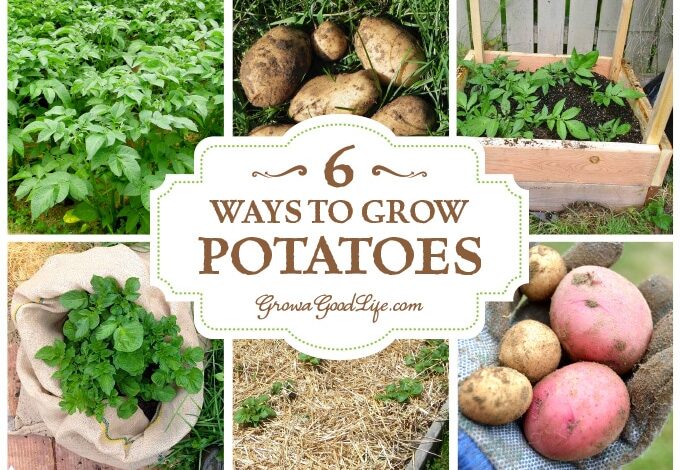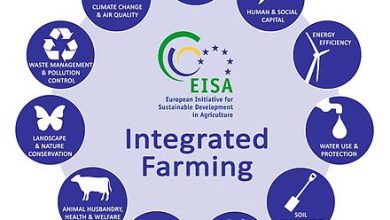6 different ways to grow potatoes

We are going to see 6 different ways to grow organic potatoes both in containers and directly in the ground.
1.- In a row
Make furrows along the bed about 15 to 20 cm deep and leave a distance between them of 30 cm to 50 cm. Go placing the potatoes in rows leaving a distance between one and the other of 30 cm. Then you cover them with about 7 or 10 cm of soil mixed with humus.
When the potatoes have already sprouted and are approximately 25 cm high, we hunt the plants, that is, we pile up soil around the stem. We will repeat this work as the plant grows to keep the tubers covered and always under the ground.
Benefits: you do not need containers or pots. It is a simple and traditional way of cultivation. It is especially interesting for large-scale plantations.
Disadvantages: if the soil tends to compact or has little organic matter, it can give little harvest
2.- Padding or straw mulch
Prepare the soil by adding organic matter before planting. Follow the planting distances of the previous method but this time cover the potatoes with 10 cm of loose and well distributed straw ( mulch or mulch ). As the plants sprout and grow, place more straw around the stem.
Benefits: mulch helps conserve soil moisture and eliminates or reduces the appearance of unwanted plants. In addition, it is not necessary to carry out tasks such as digging and manipulating the earth. It is also an agroecological way to avoid or reduce the attacks of the potato beetle.
Disadvantages: Normally the yields with this cultivation method are somewhat smaller than with row cultivation.
3.- Raised or deep bed
Prepare the soil to cultivate in raised or deep beds . This should be airy and loose. Then place the potatoes filling the entire surface but leaving a distance of 25 cm2. We cover with 10 cm of soil.
As the plants grow you should add more soil around the stems if necessary.
Benefits: It could be the most productive method and the potatoes are bigger. Raised bed cultivation is a good option for growing vegetables, especially if the soil has poor drainage and tends to become caked.
Disadvantages: a lot of land is needed
4.- Grow bags
At the bottom of the grow bag we will put the first layer of no less than 15 cm thick, which will be a mixture of equal parts of soil and compost. Then we put several potatoes and cover with another 10 cm layer of soil. We add some potatoes again and cover with another layer of soil and compost in equal parts of 10 cm. We keep repeating the same operation until we have filled the culture bag. When we go to harvest we just have to knock down the bag and remove the plants easily.
Benefits: The grow bags are very practical and can be had both in rural and urban areas, being very useful and easy to use in terraced orchards or patios. Grow bags are sturdy and last for several seasons. Those that are black in color help to accelerate growth, since they are easy to capture heat. Another benefit is that the roots have more aeration than in pots or directly in the ground. In addition, the harvests are usually quite good and abundant considering the very little space that is needed to cultivate.
Disadvantages: there are many grow bags on the market, but they are usually made from oil. Look for ones that are made from natural fibers or other organic and biodegradable materials.
5.- Boxes without wooden bottom
We simply make a box without a bottom, you can reuse pallets or even pruning branches. At first you only need to put branches or wood on the lower walls and close to the ground and you will incorporate more wooden slats as you add more soil and potatoes.
When we harvest we do it by removing the wood or branches closest to the ground or we can also do it by knocking the box down and placing it horizontally.
Benefits: it is a similar crop to the raised bed, and in fact the harvests are similar in quantity to this other cultivation method. It is also recommended for lands with little organic matter
Disadvantages: you have to build the box and, although there are only 4 vertical stakes and a few pieces of wood or branches to make the walls, if you are not used to it, it may take a long time.
6.- Wire cylinders
With wire mesh we make a cylinder of about 70 cm in diameter and 1 meter high. Then we add 15 cm of soil with humus in the bottom, we put about 4 or 5 potatoes around the outer edge and we cover them with 6 cm of soil. Continue adding layers of potatoes and soil until you reach the surface of the cylinder.
To harvest the potatoes you just have to lift the cylinder.
Benefits: this form of cultivation is especially interesting in areas with constant rains or during periods of the year with frequent rains, since the drainage is excellent and problems related to water stagnation are avoided, such as root rot and rot. bad growth.
Disadvantages: harvests are more limited than other forms of crops.


![Photo of How to Plant Rosemary in [12 Steps and with Photos]](https://www.complete-gardening.com/wp-content/uploads/2022/08/how-to-plant-rosemary-in-12-steps-and-with-photos-390x220.jpg)
